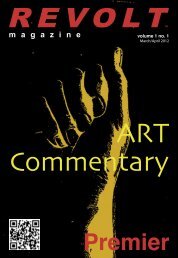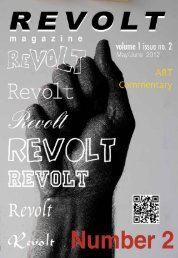Download PDF Version Revolt Magazine, Volume 1 Issue No.4
Download PDF Version Revolt Magazine, Volume 1 Issue No.4
Download PDF Version Revolt Magazine, Volume 1 Issue No.4
You also want an ePaper? Increase the reach of your titles
YUMPU automatically turns print PDFs into web optimized ePapers that Google loves.
Art &<br />
Politics:Fracking<br />
Drawingtheline<br />
BY LINDA DIGUSTA<br />
Alice Zinnes is a force of nature. An environmental<br />
activist in the movement to halt the use of the<br />
controversial natural gas extraction process<br />
called hydraulic fracturing (often referred to as<br />
“fracking”), for the past few years she has worked<br />
at least 30 hours each week on activities related<br />
to her cause. Her dedication would be remarkable<br />
even if she had not already devoted herself to<br />
another demanding calling – art.<br />
A lifelong environmentalist -- “At least since second<br />
grade when a NYC drought was so upsetting to me<br />
that I would turn off the running water while my<br />
mom washed the dishes.” -- in high school Zinnes<br />
headed the Ecology Club, which started a recycling<br />
program in the community. She applied to college<br />
intending to major in environmental science, but<br />
while in school, she fell in love with painting.<br />
Now an artist and teacher at Pratt Institute, Alice<br />
became aware of hydraulic fracturing when drilling<br />
was proposed near her Pennsylvania home in the<br />
Upper Delaware River Basin. “At first,” she said,<br />
“I couldn't believe they would frack the Delaware<br />
River, since it supplies drinking water to 16 million<br />
people.”<br />
Viewing Josh Fox’s documentary “Gasland” raised<br />
her awareness, and her involvement deepened<br />
when she organized an art benefit for Damascus<br />
Citizens for Sustainability, the grassroots<br />
organization that Gasland is dedicated to and<br />
one of the first on the East Coast to publicize the<br />
dangers of fracking. She recalls, “I then created<br />
what I thought would be a small email list for<br />
residents of the Upper Delaware, as a way to<br />
quickly disseminate information, but through<br />
word-of-mouth, this list pretty quickly went viral,<br />
connecting people from upstate NY to Louisiana, to<br />
Texas and Ohio.”<br />
“As I became relied upon by others, I simply<br />
accepted my new responsibilities,” said Zinnes,<br />
who sends multiple emails almost daily to the<br />
group. “Some of these people I actually see, while<br />
others live all over the country... I've been surprised<br />
at the powerful community we have become. I feel<br />
we are like soldiers in a platoon: loyal, supportive,<br />
understanding, and dependent on each other for<br />
our very survival.”<br />
REVOLT<br />
<strong>Magazine</strong> Number 4, 2013<br />
Behind every issue confronting us as citizens,<br />
there are people working hard to raise awareness<br />
and support for their causes. In the case of the<br />
groundswell against the practice of hydraulic<br />
fracturing, the vanguard includes names we<br />
all already know, like Yoko Ono, Mark Ruffalo,<br />
and “Gasland” filmmaker Fox, who garnered an<br />
Academy Award nomination for best documentary<br />
feature.<br />
Also on the front lines are those most directly<br />
impacted by the drilling, working constantly to<br />
get the word out in the hope that others will learn<br />
more and take a stand when they realize that<br />
fracking, in the long run, affects everyone. “Getting<br />
involved is an ongoing journey with numerous<br />
conversations, reading about environmental and<br />
health issues, studying reports about geology<br />
and financial aspects, and getting to know an<br />
impressive, knowledgeable community of people<br />
who are working to protect rights for a clean<br />
planet,” said another anti-fracking artist/organizer,<br />
Ruth Hardinger. “The first event I organized was a<br />
talk upstate in January 2010. Wes Gillingham from<br />
Catskill Mountainkeeper drove through a blizzard to<br />
speak about the impacts of fracking.”<br />
To bring awareness to a wider audience and<br />
mobilize more artists, Zinnes, Hardinger, and artist<br />
Peggy Cyphers curated the 2010-2011 exhibition<br />
“Fracking: Art & Activism Against the Drill” at Exit<br />
Art in Manhattan. Working with the Exit Art staff,<br />
they put together a group exhibition featuring work<br />
addressing the issue by 60 artists. The program<br />
also included a talk with a panel of leading figures<br />
in the movement, attended by over 300 people in<br />
spite of another blizzard. Many attendees of the<br />
event went on to become important players in the<br />
“fractivist” movement.<br />
“Fracking became an important issue for me about<br />
7 years ago, when I was traveling in Peru, and<br />
learned about mineral rights and the government's<br />
claim to any resources immediately below the<br />
surface of the earth,” said Christy Rupp, an artist<br />
who participated in both the show and the panel.<br />
“Even if it was just a few inches under a farmer's<br />
field, if oil or gas or rare earth metals were<br />
discovered, the rights to extract are owned by the<br />
government.”<br />
Noticing a parallel threat to communities here,<br />
Rupp, as she describes below, explored the issue<br />
further:<br />
“Wishing to connect the dots, I started to learn<br />
more about the 30 year ongoing oil spill in the<br />
Ecuadorean Amazon, in which since the 70's<br />
Texaco, and then Chevron were dumping formation<br />
water the (waste product from oil drilling) directly<br />
into shallow surface ponds, which then would leach<br />
out … entering people's farmland, their homes,<br />
their wells. The government of Ecuador's response<br />
was to cater to the oil companies lethal habits,<br />
giving them more lucrative drilling contracts in the<br />
Amazon region, and using the waste to spread<br />
on roads to keep down the dust created by the<br />
heavy traffic needed to support drilling. People<br />
in that region suffer birth defects, cancers and<br />
miscarriages at a rate far higher than normal. The<br />
government wants to either ignore the problem or<br />
just condemn the area and force people to leave,<br />
the problem can't be cleaned up with money.”<br />
After visiting areas of West Virginia devastated by<br />
coal mining, Rupp is hoping to bring the message<br />
home before it is too late. “Fracking,” she explains,<br />
“Like Tar Sands, oil drilling and coal, takes the<br />
land people have used historically for sustenance<br />
and sacrifices entire regions.” As she sees it, the<br />
practice generates massive profits for a very few<br />
individuals at the expense of many, and “We are<br />
witness to a land grab, or a transferring of wealth,<br />
similar to the banking crisis, the looting of the Post<br />
Office, or the desire to privatize social security.”<br />
Peggy Cyphers, another life-long activist, is also<br />
intent on drawing the line on hydraulic fracturing,<br />
at least where she lives. “The anti-fracking<br />
movement has been taking on big money and<br />
big business, and many networks of grassroots<br />
activists are fighting back…My sister Jane Cyphers<br />
and her husband Joe Levine are founding members<br />
of Damascus Citizens for Sustainability and got<br />
me involved,” she said. “The best part of New<br />
York State is that we have the watershed, so the<br />
discussion is huge and in a way it keeps us safe.<br />
Not so for Pennsylvania and Ohio, that's a done<br />
deal as every landowner is selling out.”<br />
A ceramic artist and creator of the aptly named<br />
Earthgirl Pottery, Jill Wiener is a Calicoon, NY<br />
26





